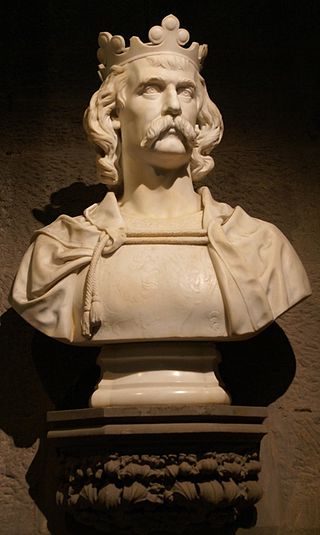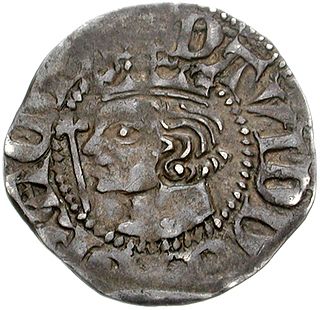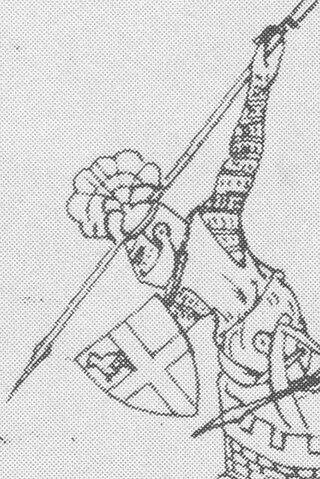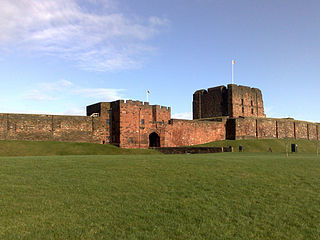
Robert I, popularly known as Robert the Bruce, was King of Scots from 1306 to his death in 1329. Robert led Scotland during the First War of Scottish Independence against England. He fought successfully during his reign to restore Scotland to an independent kingdom and is regarded in Scotland as a national hero.

The Wars of Scottish Independence were a series of military campaigns fought between the Kingdom of Scotland and the Kingdom of England in the late 13th and early 14th centuries.

Edward II, also known as Edward of Caernarfon or Caernarvon, was King of England from 1307 until he was deposed in January 1327. The fourth son of Edward I, Edward became the heir to the throne following the death of his older brother Alphonso. Beginning in 1300, Edward accompanied his father on campaigns in Scotland, and in 1306 he was knighted in a grand ceremony at Westminster Abbey. Edward succeeded to the throne the next year, following his father's death. In 1308, he married Isabella of France, the daughter of the powerful King Philip IV, as part of a long-running effort to resolve the tensions between the English and French crowns.

David II was King of Scotland from 1329 until his death in 1371. Upon the death of his father, Robert the Bruce, David succeeded to the throne at the age of five and was crowned at Scone in November 1331, becoming the first Scottish monarch to be anointed at his coronation. During his childhood, David was governed by a series of guardians, and Edward III of England sought to take advantage of David's minority by supporting an invasion of Scotland by Edward Balliol, beginning the Second War of Scottish Independence. Following the English victory at the Battle of Halidon Hill in 1333, King David, Queen Joan and the rump of his government were evacuated to France, where he remained in exile until it was safe for him to return to Scotland in 1341.

The Battle of Boroughbridge was fought on 16 March 1322 in England between a group of rebellious barons and the forces of King Edward II, near Boroughbridge, north-west of York. The culmination of a long period of antagonism between the King and Thomas, Earl of Lancaster, his most powerful subject, it resulted in Lancaster's defeat and execution, ending the Despenser War. This allowed Edward to re-establish royal authority and hold on to power for almost five more years.

Andrew Harclay, 1st Earl of Carlisle, alternatively Andreas de Harcla, was an important English military leader in the borderlands with Scotland during the reign of Edward II. Coming from a knightly family in Westmorland, he was appointed sheriff of Cumberland in 1311. He distinguished himself in the Scottish Wars, and in 1315 repulsed a siege on Carlisle Castle by Robert the Bruce. Shortly after this, he was taken captive by the Scots, and only released after a substantial ransom had been paid. His greatest achievement came in 1322, when he defeated the rebellious baron Thomas of Lancaster at the Battle of Boroughbridge on 16–17 March. For this he was created Earl of Carlisle.

The Battle of Neville's Cross took place during the Second War of Scottish Independence on 17 October 1346, half a mile to the west of Durham, England. An invading Scottish army of 12,000 led by King David II was defeated with heavy loss by an English army of approximately 6,000–7,000 men led by Ralph Neville, Lord Neville. The battle was named after an Anglo-Saxon stone cross that stood on the hill where the Scots made their stand. After the victory, Neville paid to have a new cross erected to commemorate the day.

Aymer de Valence, 2nd Earl of Pembroke was an Anglo-French nobleman. Though primarily active in England, he also had strong connections with the French royal house. One of the wealthiest and most powerful men of his age, he was a central player in the conflicts between Edward II of England and his nobility, particularly Thomas, 2nd Earl of Lancaster. Pembroke was one of the Lords Ordainers appointed to restrict the power of Edward II and his favourite Piers Gaveston. His position changed with the great insult he suffered when Gaveston, as a prisoner in his custody whom he had sworn to protect, was removed and beheaded at the instigation of Lancaster. This led Pembroke into close and lifelong cooperation with the king. Later in life, however, political circumstances combined with financial difficulties would cause him problems, driving him away from the centre of power.
Humphrey (VII) de Bohun, 4th Earl of Hereford was a member of a powerful Anglo-Norman family of the Welsh Marches and was one of the Ordainers who opposed Edward II's excesses.

Dryburgh Abbey, near Dryburgh on the banks of the River Tweed in the Scottish Borders, was nominally founded on 10 November (Martinmas) 1150 in an agreement between Hugh de Morville, Constable of Scotland, and the Premonstratensian canons regular from Alnwick Abbey in Northumberland. The arrival of the canons along with their first abbot, Roger, took place on 13 December 1152.

St Mary's Abbey, Melrose is a partly ruined monastery of the Cistercian order in Melrose, Roxburghshire, in the Scottish Borders. It was founded in 1136 by Cistercian monks at the request of King David I of Scotland and was the chief house of that order in the country until the Reformation. It was headed by the abbot or commendator of Melrose. Today the abbey is maintained by Historic Environment Scotland as a scheduled monument.

Furness Abbey, or St. Mary of Furness, is a former monastery located to the north of Barrow-in-Furness, Cumbria, England. The abbey dates back to 1123 and was once the second-wealthiest and most powerful Cistercian monastery in the country, behind Fountains Abbey, prior to its dissolution during the English Reformation. The abbey contains a number of individual Grade I Listed Buildings and is a Scheduled Monument.

Thomas Randolph, Earl of Moray was a soldier and diplomat in the Wars of Scottish Independence, who later served as regent of Scotland. He was a nephew of Robert the Bruce, who created him as the first earl of Moray. He was known for successfully capturing Edinburgh Castle from the English, and he was one of the signatories of the Declaration of Arbroath.

Clan Bruce is a Lowlands Scottish clan. It was a royal house in the 14th century, producing two kings of Scotland, and a disputed High King of Ireland, Edward Bruce.
Gilbert de Clare, 8th Earl of Gloucester, 7th Earl of Hertford was an English nobleman and military commander in the Scottish Wars. In contrast to most English earls at the time, his main focus lay in the pursuit of war rather than in domestic political strife. He was the son of Gilbert de Clare, 7th Earl of Gloucester, and Joan of Acre, daughter of King Edward I. The older Gilbert died when his son was only four years old, and the younger Gilbert was invested with his earldoms at the young age of sixteen. Almost immediately, he became involved in the defense of the northern border, but later he was drawn into the struggles between Edward II and some of his barons. He was one of the Lords Ordainers who ordered the expulsion of the king's favourite Piers Gaveston in 1311. When Gaveston was killed on his return in 1312, Gloucester helped negotiate a settlement between the perpetrators and the king.

The Battle of Old Byland was a significant encounter between Scots and English troops in Yorkshire in October 1322, forming part of the Wars of Scottish Independence. It was a victory for the Scots, the most significant since Bannockburn.

The siege of Carlisle took place from 22 July to 1 August 1315, during the First War of Scottish Independence, near the town of Carlisle, in Cumbria, England.
The Second War of Scottish Independence broke out in 1332, when Edward Balliol led an English-backed invasion of Scotland. Balliol, the son of former Scottish king John Balliol, was attempting to make good his claim to the Scottish throne. He was opposed by Scots loyal to the occupant of the throne, eight-year-old David II. At the Battle of Dupplin Moor Balliol's force defeated a Scottish army ten times their size and Balliol was crowned king. Within three months David's partisans had regrouped and forced Balliol out of Scotland. He appealed to the English king, Edward III, who invaded Scotland in 1333 and besieged the important trading town of Berwick. A large Scottish army attempted to relieve it but was heavily defeated at the Battle of Halidon Hill. Balliol established his authority over most of Scotland, ceded to England the eight counties of south-east Scotland and did homage to Edward for the rest of the country as a fief.

The Weardale campaign, part of the First War of Scottish Independence, occurred during July and August 1327 in Weardale, England. A Scottish force under James, Lord of Douglas, and the earls of Moray and Mar faced an English army commanded by Roger, Lord Mortimer of Wigmore, accompanied by the newly crowned Edward III.
The English invasion of Scotland of 1296 was a military campaign undertaken by Edward I of England in retaliation to the Scottish treaty with France and the renouncing of fealty of John, King of Scotland and Scottish raids into Northern England.















